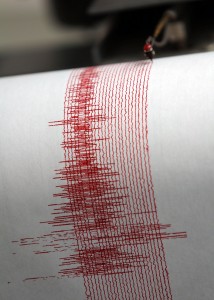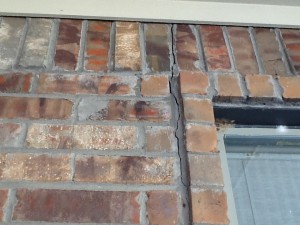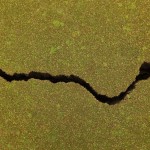As Texas Towns Shake, Regulators Sit Still

Photo: OLIVER BERG DPA/LANDOV
After 20 earthquakes in a month, will state regulators respond?
State Oil and Gas Regulator Says No Changes Needed After Latest Earthquake Swarm
After twenty minor earthquakes in a month, residents in the small towns of Azle and Springtown outside of Fort Worth are understandably confused about why their once-stable region is now trembling on a near-daily basis.
Teachers in the Azle school district are taking a page from the California playbook and holding earthquake drills for students. Inspectors are making regular visits to the earthen Eagle Mountain Lake dam, as well as others in the area, checking for damage. (So far they’ve found none.) And locals like Rebecca Williams are constantly looking at their own homes for damage. So far she’s found cracks in her home, driveway and in a retaining wall in her backyard.
The quakes have been small, below the threshold that is known to cause significant damage. But they’ve unnerved residents like Williams, who moved out to Eagle Mountain Lake looking for some peace and quiet.
“You can actually see my house rocking from side to side,” Williams says. She was at home when the largest of the quakes (magnitude 3.6) struck on the evening of November 19th. “I tried to get up and run downstairs,” she says. “And for a moment, I couldn’t run, because the house was shaking so bad!”
So what’s behind the tremors?

Photo courtesy of Rebecca Williams
Rebecca Williams of Azle says these cracks appeared in her home after the quakes started last month.
There were no quakes in the Dallas-Fort Worth and surrounding areas (including Azle) before 2007, according to records from the United States Geological Survey. But the region is part of the Barnett Shale, where the drilling process known as hydraulic fracturing, or “fracking,” has taken off in recent years, leading some to question whether or not fracking is at fault.
Fracking is probably not directly causing the quakes. But a byproduct of all that drilling – wastewater – could be the culprit. Studies of other earthquake swarms in this region of Texas, as well as in other states like Arkansas and Ohio, have shown that the injection of that drilling wastewater deep underground can cause faults to slip, triggering quakes.
When drillers go after deposits of oil and gas through fracking, they’re typically using water to do it — millions of gallons per well. When that water comes back up, it’s called “flowback.” And when drillers reach the oil and gas deposits, a large amount of dirty water mixed with the oil and gas comes back up with it, called “produced water.” The standard industry practice is to dispose of that wastewater (both the fracking flowback and produced water) by injecting it deep underground.
The amount of wastewater produced by oil and gas drilling in Texas is substantial. The state is currently disposing of some 290 million barrels (or nine billion gallons) of wastewater a month. To put that number into perspective, a year’s worth of the drilling wastewater being disposed of in Texas is close to the same amount of water currently sitting in Lake Buchanan, a large reservoir that provides drinking water for Central Texas.
In some areas of Texas where that wastewater is injected into existing faults (some of which have been dormant until now) at high pressure, quakes can occur. At the same time, there are tens of thousands of disposal wells in Texas, and the geology varies across the state. Not all of them are causing quakes.
Texas also isn’t alone in seeing more shaking than its used to. “The number of earthquakes has increased dramatically over the past few years within the central and eastern United States,” the United States Geological Survey says on its website. “More than 300 earthquakes above a magnitude 3.0 occurred in the three years from 2010-2012, compared with an average rate of 21 events per year observed from 1967-2000.” The USGS says that at some of those locations, disposal wells are behind the quakes.
Ken Morgan, Director of the Energy Institute at Texas Christian University, says it’s likely that oil and gas wastewater disposal wells are behind the Eagle Mountain Lake quakes. And that means something can be done about it.
“If indeed – and we don’t know for sure, but it looks like if there are disposal well issues – first of all, the first line of solution is for those operators to do the right thing and back down on fluid injection,” Morgan says.
That’s pretty much what happened after a series of earthquakes at the Dallas-Fort Worth airport were tied to a disposal well there. The owners voluntarily stopped injecting wastewater, and eventually the quakes subsided.
In the case of the quakes around Azle and Eagle Mountain Lake over the past month, there are several active disposal wells in the area, as you can see in the map of quakes and disposal wells below:
View North Texas Earthquakes in a larger map
A map of recent earthquakes (in red) and oil and gas wastewater disposal wells outside of Fort Worth. Active disposal wells are in green; inactive wells are in yellow. Map by Michael Marks/Terrence Henry
Pull up records for those disposal wells and you’ll find that they’re not even injecting wastewater at the maximum allowed rate, 25,000 barrels (or 24.4 million gallons) a day. (To put that into perspective, that’s enough liquid to fill over 36 Olympic swimming pools a month.)
The XTO Energy disposal well, for instance, just north of Azle, first began disposing of wastewater in June 2009. This July, according to state records, the well disposed of over 253,000 barrels of wastewater. In August, the amount jumped to over 354,000 barrels.
Cliff Frohlich, Associate Director at the Institute for Geophysics at University of Texas at Austin, has been at the forefront of researching the new swarms of manmade quakes in Texas. In his previous studies of other quakes in the Dallas-Fort Worth area, he found that disposal wells injecting at higher rates (while staying well below their permitted limits) were likely to be causing quakes.
“The injection rates were pretty high,” Frohlich told StateImpact Texas earlier this year. “More than 150,000 barrels per month, at least some months, in these wells. Whereas the wells with lower injection rates didn’t have earthquakes near them.”
The XTO Energy disposal well near the quakes has been injecting well above the level of 150,000 barrels per month since it began operating several years ago. Another disposal well, northwest of Azle, operated by Bridgeport Tank Trucks, has also been injecting large amounts — as much as 400,000 barrels of wastewater per month, according to records on file with the Railroad Commission of Texas. That well is east of most of the quakes but quite close to two of them, one of which measured 3.0.
How to address the issue? The United States Geological Survey has informally proposed setting a threshold for what level of “induced seismicity” (aka manmade earthquakes) is safe. They call it a “traffic-light” system: if, say, quakes near a disposal well start occurring above a certain level of strength, the amount of wastewater being injected for disposal would be reduced. “If seismicity continued or escalated, operations could be suspended,” the agency writes.
More timely data would also help, the federal agency notes. Currently, disposal wells provide data on their injection rates to the state on a monthly basis. But with daily reporting and more data on the pressure of injection, agencies would have a better picture of manmade earthquakes, the USGS says.
But don’t look to the state agency in charge of disposal wells in Texas to provide any similar guidance on the matter. The Railroad Commission of Texas, which oversees oil and gas drilling in the state, says they’re not currently considering any policy changes in response to the tremors, whether it be the current earthquake swarm in Azle or other quakes linked to oil and gas activity, like a string of quakes to the south in Cleburne.
Indeed, it’s not clear that the commission could do much at the moment if it wanted to. Under state law, they cannot suspend a disposal well permit unless the operator is in violation of commission rules. And with no rules on seismicity, a disposal well can be suspected of causing quakes, but without a rule change, the commission would have no authority to shut it down.
The commission has inspected one disposal well near the Azle quakes after the swarm began, and found it was in compliance with their permits. Those permits require disposal well operators to protect usable quality water in the area, but do not have any requirements for preventing manmade earthquakes.
Beyond the issue of manmade quakes caused by disposal wells, there’s also the question of what to do about other areas of Texas that are seeing quakes associated with drilling activity. Frohlich’s research has found that in the South Texas Eagle Ford Shale, oil and gas extraction (as well as some disposal) is likely causing quakes in the region, the largest, in October 2011, measuring 4.8.
In West Texas, near the town of Snyder, there’s a different culprit likely behind the quakes there, according to Frohlich’s research: the injection of carbon dioxide into underground formations. That’s a method drillers use to get leftover deposits of oil and gas. Those activities likely led to a string of 18 quakes measuring 3.0 or higher from 2006 to 2012, the study suggests, with the largest a 4.4 quake in September 2011. 4.0 and higher is generally believed to be the level at which quakes can cause damage, though it can depend on how densely populated (and prepared) an area is.
The Railroad Commission says it is aware of Frohlich’s several peer-reviewed studies and other studies and research (including by the United States Geological Survey) linking disposal wells and other drilling activity to manmade quakes. But it publicly calls links between quakes and drilling activity “theories.”
The commission also says it is not considering any new measures to deal with the quakes, like seismic testing of the surrounding area for faults before issuing a permit for disposal. As for tracking which disposal well operators have shut down their wells because of links to manmade earthquakes, the commission says they don’t do that, either.
In emails obtained from the Railroad Commission through an Open Records request this year, StateImpact Texas found that staff at the commission are aware of the press coverage of the manmade quakes, as well as some of the science behind the phenomena. Doug Johnson, a permitting manager for disposal wells at the commission, wrote in a March 2012 email to a Denton resident concerned about quakes that “induced seismicity” can happen “due to a number of different types of human activity, including subsurface fluid injection.” (You can read the email below.)
Johnson goes on to say that such events that can be heard or felt are “extremely rare” and “induced seismicity is unpredictable by current science.” Even with the caveats, Johnson appears to go much farther to acknowledge the issue than the commission has publicly. The commission has repeatedly stated that “Texas has a long history of safe oil and gas activity, and staff has not identified a significant correlation between faulting and injection practices.”
Other questions remain. Who bears the cost for the damage and disruptions caused by the quakes? While the Texas quakes haven’t caused widespread damage yet, they have cracked foundations, broken windows, and toppled chimneys and televisions. They’ve also caused 911 call centers to be overwhelmed when the quakes occur. What will happen to infrastructure in Texas that may not designed to withstand bigger tremors — like pipelines, water towers, or dams — is another open question.
Without earthquake insurance, the costs of the quakes are likely to fall on citizens themselves, but it’s not clear if the Texas quakes are strong enough to warrant such a move. After swarms of stronger quakes over the last few years in Oklahoma possibly linked to disposal wells, one of which destroyed over a dozen homes, the state’s Insurance commissioner is asking Oklahomans to buy earthquake insurance.
There have been some lawsuits filed in Texas and other states against drilling companies alleging that they’re responsible. Some homeowners in Johnson County, which Frohlich studied, have alleged property damage from some of the quakes and filed a lawsuit this summer against several drilling companies.
“I wouldn’t like it myself, under my home,” Morgan of TCU says of the quakes. “I would like them to stop.”


